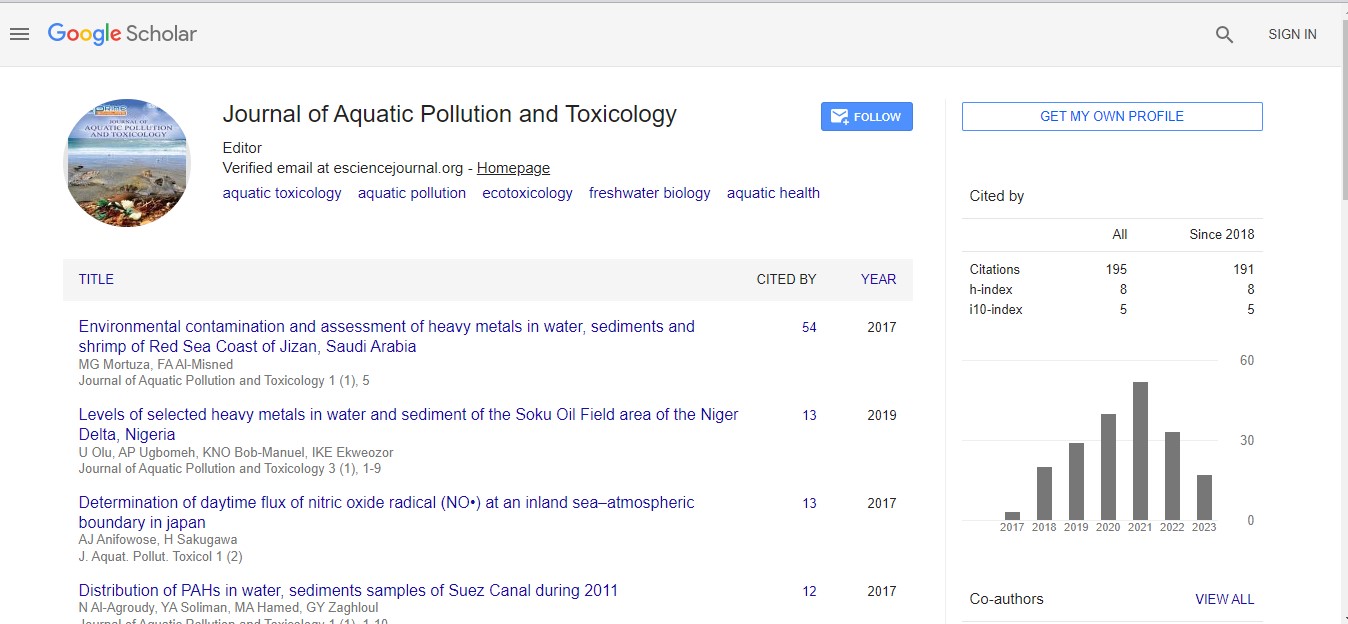Short Communication - (2024) Volume 8, Issue 4
Aqua Pollution: A Growing Crisis for Our Water Ecosystems
Noah Alcott*
Department of Aquatic Pollution, Brigham Young University, USA
*Correspondence:
Noah Alcott,
Department of Aquatic Pollution, Brigham Young University,
USA,
Email:
Received: 02-Dec-2024, Manuscript No. IPJAPT-24-22021;
Editor assigned: 04-Dec-2024, Pre QC No. IPJAPT-24-22021 (PQ);
Reviewed: 18-Dec-2024, QC No. IPJAPT-24-22021;
Revised: 23-Dec-2024, Manuscript No. IPJAPT-24-22021 (R);
Published:
30-Dec-2024, DOI: 10.21767/2581-804X-8.4.32
Introduction
Aqua pollution, or water pollution, is one of the most pressing
environmental challenges facing the planet today. It refers
to the contamination of water bodies such as rivers, lakes,
oceans, and groundwater by harmful substances that degrade
water quality and pose risks to human health, aquatic life, and
entire ecosystems. As human populations continue to grow
and industrial activity expands, the burden on freshwater
and marine environments intensifies, leading to significant
consequences for both the natural world and the global
population. This article explores the causes and effects of
aqua pollution, the risks it poses, and the steps needed to
combat this growing crisis. Water pollution arises from a
variety of sources, both natural and human-made. The major
contributors include. Factories and industries discharge a wide
range of toxic chemicals, heavy metals, and waste products into
rivers and oceans. These pollutants can include substances like
mercury, lead, arsenic, and solvents, which can poison aquatic
life and contaminate drinking water supplies.
Description
In some cases, industrial waste may also contain radioactive
materials or plastics, which persist in the environment for
decades. One of the most significant contributors to water
pollution is agricultural runoff. Fertilizers, pesticides, and
herbicides used in farming often wash into nearby rivers,
lakes, and coastal areas during rainstorms. Pesticides can
also harm non-target species, including beneficial insects
and aquatic organisms. In many parts of the world, untreated
sewage and wastewater are directly discharged into rivers,
lakes, and oceans. This type of pollution introduces harmful
bacteria, viruses, and pathogens into the water, leading to
serious public health risks. Waterborne diseases such as
cholera, dysentery, and typhoid fever are often spread through
contaminated water sources. Plastics are one of the most
pervasive pollutants in the worldâ??s oceans. Oil spills, often
resulting from shipping accidents, offshore drilling operations,
and pipeline leaks, are another significant cause of water
pollution. The introduction of heavy metals into water bodies
can lead to the accumulation of these toxins in the tissues of
aquatic species, making them unsafe for human consumption.
Contaminated water is a major source of diseases worldwide.
Waterborne pathogens can cause a wide range of illnesses,
including gastrointestinal infections, cholera, and dysentery. In
regions with poor sanitation infrastructure, untreated sewage
often pollutes drinking water sources, leading to outbreaks of
disease. Additionally, the consumption of fish or other aquatic
organisms contaminated with heavy metals, such as mercury,
can pose serious health risks to humans, including neurological
damage and developmental issues in children [1-4].
Conclusion
Water pollution disrupts entire ecosystems, from freshwater
lakes to the open ocean. When aquatic habitats are degraded,
it can lead to the loss of biodiversity, with species unable to
survive or reproduce. Wetlands, which play crucial roles in
water filtration and carbon sequestration, are especially
vulnerable to contamination and destruction, leading to
further ecological imbalances. The economic impact of water
pollution is immense. It affects industries that depend on clean
water, such as fishing, tourism, and agriculture. Fishermen
lose income when fish populations decline due to pollution,
while tourism can suffer as polluted beaches and water bodies
discourage visitors. By understanding its causes, recognizing its
impact, and taking collective action to reduce pollutants, we
can help protect the worldâ??s freshwater and marine resources.
It is essential for governments, industries, and individuals to
work together to prevent further degradation of our water
sources and ensure that clean water remains available for
future generations.
Acknowledgement
None.
Conflict Of Interest
The author declares there is no conflict of interest in publishing
this article.
References
- Davidovich N, Morick D, Carella F (2020) Mycobacteriosis in aquatic invertebrates: A review of its emergence. Microorganisms 8(8):1249.
[Crossref] [Google Scholar] [PubMed]
- Roostaei M, Baharlouei H, Azadi H, Fragala-Pinkham MA (2017) Effects of aquatic intervention on gross motor skills in children with cerebral palsy: A systematic review. Phys Occup Ther Pediatr 37(5):496-515.
[Crossref] [Google Scholar] [PubMed]
- Litchman E, Klausmeier CA (2008) Trait-based community ecology of phytoplankton. Annu Rev Ecol Evol Syst 39(5): 615â??639.
[Crossref] [Google Scholar]
- Cermeno P, Choucino P, Fernandez CB, Figueiras FG, Maranon E, et al. (2016) Marine primary productivity is driven by a selection effect. Front Mar Sci 3(1): 173.
[Crossref] [Google Scholar]
Citation: Alcott N (2024) Aqua Pollution: A Growing Crisis for our Water Ecosystems. J Aquat Pollut Toxicol. 8:32.
Copyright: © 2024 Alcott N. This is an open-access article distributed under the terms of the Creative Commons Attribution License, which permits unrestricted use, distribution, and reproduction in any medium, provided the original author and source are credited.

